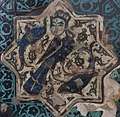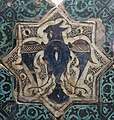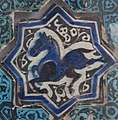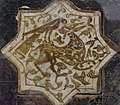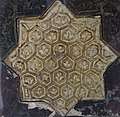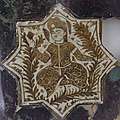Kubadabad Palace
Kubadabad Palace or Kubad Abad Palace (Turkish: Kubadabad Sarayı) was a complex of summer residences built for sultan Kayqubad I (1220–1237), ruler of the Sultanate of Rum. The palace is located on the southwestern shores of Lake Beyşehir in south-west Central Anatolia, Turkey, just over 100 kilometers west of the Seljuq capital at Konya.
| Kubadabad Palace | |
|---|---|
 | |
| General information | |
| Type | Palace |
| Location | Lake Beyşehir, Turkey |
| Coordinates | 37°44′36.5″N 31°26′21.4″E |
| Construction started | early 13th century |
| Owner | Turkish state |
Site of palace
The site was formerly only known from the descriptions of the contemporary historian Ibn Bibi, who wrote that toward the end of his reign Kayqubad himself drew up plans for the palace and assigned responsibility for their completion to his vizier Sa'd al-Din Köpek.[1] The palace remains were discovered in 1949 and subsequently excavated, first in the 1960s by German archaeologist Katharina Otto-Dorn and more recently by a team from Ankara University led by Rüçhan Arık.[2]
The complex comprises sixteen buildings, including two palaces, the larger of which is known as the Great Palace and measures fifty by thirty-five metres. Among its features are a game park and a small wooden dockyard that replicates the Tersane at Alanya.[1] The Great Palace is an asymmetrical structure incorporating a courtyard, guest rooms, a harem and eyvan. It is remarkable for its ornate figural tiles, and its innovative layout, modeled on the caravansarai, reflects a break with the traditional pavilion structure that characterised earlier palaces.[3]
Kubadabad Palace is unusual for a Seljuq palace in that its location is so far from a fortified town, in contrast to palaces at Konya and Kayseri. Protection seems to have been provided by a fortress complex located on the nearby island of Kız Kalesi.[4] Other ruins in the area include the important Hittite site of Eflatunpınar.
Tiles
Excavations at Kubadabad Palace uncovered a magnificent series of polychrome ceramic tiles now held in Konya's Karatay Museum. Painted with an underglaze of blue, purple, turquoise and green, the series consists of white, star-shaped figural panels alternating with turquoise crosses. Similar tiling has also been found on the Roman theater at Aspendos, which Kayqubad had converted into a palace. The subjects of the tiles include humans, and animals both real and fantastic. Of particular interest are two tiles thought to show a portrait of the sultan[5] and another showing a double-headed eagle inscribed "al-sultān." The same symbols appear on other works sponsored by Kayqubad, such as the city walls of Konya.[3]
See also
References
- Aslanapa 1971, p. 163.
- "Kubadabad Sarayi". ArchNet. Retrieved 27 March 2019.
- Redford 1993, p. 221.
- Redford 1993, p. 220.
- Aslanapa 1971, p. 273.
Sources
- Aslanapa, Oktay (1971). Turkish Art and Architecture. New York: Praeger.CS1 maint: ref=harv (link)
- Redford, Scott (1993). "Thirteenth-century Rum Seljuq palaces and palace imagery" (PDF). Ars Orientalis. 23: 219–236. JSTOR 4629450.CS1 maint: ref=harv (link)
Further reading
- Arık, Rüçhan (2000). Kubad Abad (in Turkish). Istanbul: Türkiye İş Bankası. ISBN 975-458-265-3.
- Aslanapa, Oktay (1991). Anadolu'da ilk Türk mimarisi: Başlangıcı ve gelişmesi [Early Turkish architecture in Anatolia: Beginnings and development] (in Turkish). Ankara: AKM Publications. ISBN 975-16-0264-5.
- Gierlichs, Joachim (2001). "In Memoriam Katharina Otto-Dorn: A life dedicated to Turkish Islamic art and architecture" (PDF). Electronic Journal of Oriental Studies (EJOS). 4 (21): 1–14.
External links
- Katharine Branning. "Seljuq ceramics". and "Seljuq glass".
- Yılmaz, Meliha (2001). "A correction for a dragon figured tile in Kubadabad Palace". Gazi University.

